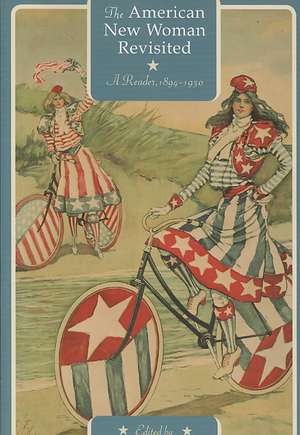The American New Woman Revisited: A Reader, 1894-1930
Editat de Martha H. Pattersonen Limba Engleză Paperback – mai 2008 – vârsta ani
In North America between 1894 and 1930, the rise of the “New Woman” sparked controversy on both sides of the Atlantic and around the world. As she demanded a public voice as well as private fulfillment through work, education, and politics, American journalists debated and defined her. Who was she and where did she come from? Was she to be celebrated as the agent of progress or reviled as a traitor to the traditional family? Over time, the dominant version of the American New Woman became typified as white, educated, and middle class: the suffragist, progressive reformer, and bloomer-wearing bicyclist. By the 1920s, the jazz-dancing flapper epitomized her. Yet she also had many other faces.
Bringing together a diverse range of essays from the periodical press of the late nineteenth and early twentieth centuries, Martha H. Patterson shows how the New Woman differed according to region, class, politics, race, ethnicity, and historical circumstance. In addition to the New Woman’s prevailing incarnations, she appears here as a gun-wielding heroine, imperialist symbol, assimilationist icon, entrepreneur, socialist, anarchist, thief, vamp, and eugenicist. Together, these readings redefine our understanding of the New Woman and her cultural impact.
Bringing together a diverse range of essays from the periodical press of the late nineteenth and early twentieth centuries, Martha H. Patterson shows how the New Woman differed according to region, class, politics, race, ethnicity, and historical circumstance. In addition to the New Woman’s prevailing incarnations, she appears here as a gun-wielding heroine, imperialist symbol, assimilationist icon, entrepreneur, socialist, anarchist, thief, vamp, and eugenicist. Together, these readings redefine our understanding of the New Woman and her cultural impact.
Preț: 190.56 lei
Preț vechi: 257.84 lei
-26% Nou
Puncte Express: 286
Preț estimativ în valută:
36.47€ • 39.60$ • 30.63£
36.47€ • 39.60$ • 30.63£
Carte indisponibilă temporar
Doresc să fiu notificat când acest titlu va fi disponibil:
Se trimite...
Preluare comenzi: 021 569.72.76
Specificații
ISBN-13: 9780813542966
ISBN-10: 0813542960
Pagini: 340
Ilustrații: 25
Dimensiuni: 159 x 235 x 36 mm
Greutate: 0.62 kg
Ediția:None
Editura: Rutgers University Press
Colecția Rutgers University Press
ISBN-10: 0813542960
Pagini: 340
Ilustrații: 25
Dimensiuni: 159 x 235 x 36 mm
Greutate: 0.62 kg
Ediția:None
Editura: Rutgers University Press
Colecția Rutgers University Press
Notă biografică
Martha H. Patterson is an associate professor of English at McKendree University in Illinois and the author of Beyond the Gibson Girl: Reimagining the American New Woman, 1895-1915.
Cuprins
Contents
Acknowledgements
Introduction
Part I: Definition the New Woman in he Periodical Press
Part II: Women's Suffrage and Political Participation
Part III: Temperance, Social Purity, and Maternalism
Part IV: The Women's Club Movement and Women's Education
Part V: Work and the Labor Movement
Part VI: World War I and Its Aftermath
Part VII: Prohibition and Sexuality
Part VIII: Consumer Culture, Leisure Culture, and Technology
Part IX: Evolution, Birth Control, and Eugenics
Notes
Index
Acknowledgements
Introduction
Part I: Definition the New Woman in he Periodical Press
Part II: Women's Suffrage and Political Participation
Part III: Temperance, Social Purity, and Maternalism
Part IV: The Women's Club Movement and Women's Education
Part V: Work and the Labor Movement
Part VI: World War I and Its Aftermath
Part VII: Prohibition and Sexuality
Part VIII: Consumer Culture, Leisure Culture, and Technology
Part IX: Evolution, Birth Control, and Eugenics
Notes
Index
Recenzii
Martha Patterson is the right person for this project. I see a bright future for this book in undergraduate and graduate courses--from American literature and history to media and women's studies.
[This] collection presents varied manifestations of an icon that 'worked to define American identity' during a dynamic era. Recommended
Descriere
In North America between 1894 and 1930, the rise of the “New Woman” sparked controversy on both sides of the Atlantic and around the world. As she demanded a public voice as well as private fulfillment through work, education, and politics, American journalists debated and defined her. Who was she and where did she come from? Was she to be celebrated as the agent of progress or reviled as a traitor to the traditional family? Over time, the dominant version of the American New Woman became typified as white, educated, and middle class: the suffragist, progressive reformer, and bloomer-wearing bicyclist. By the 1920s, the jazz-dancing flapper epitomized her. Yet she also had many other faces.
Bringing together a diverse range of essays from the periodical press of the late nineteenth and early twentieth centuries, Martha H. Patterson shows how the New Woman differed according to region, class, politics, race, ethnicity, and historical circumstance. In addition to the New Woman’s prevailing incarnations, she appears here as a gun-wielding heroine, imperialist symbol, assimilationist icon, entrepreneur, socialist, anarchist, thief, vamp, and eugenicist. Together, these readings redefine our understanding of the New Woman and her cultural impact.
Bringing together a diverse range of essays from the periodical press of the late nineteenth and early twentieth centuries, Martha H. Patterson shows how the New Woman differed according to region, class, politics, race, ethnicity, and historical circumstance. In addition to the New Woman’s prevailing incarnations, she appears here as a gun-wielding heroine, imperialist symbol, assimilationist icon, entrepreneur, socialist, anarchist, thief, vamp, and eugenicist. Together, these readings redefine our understanding of the New Woman and her cultural impact.
